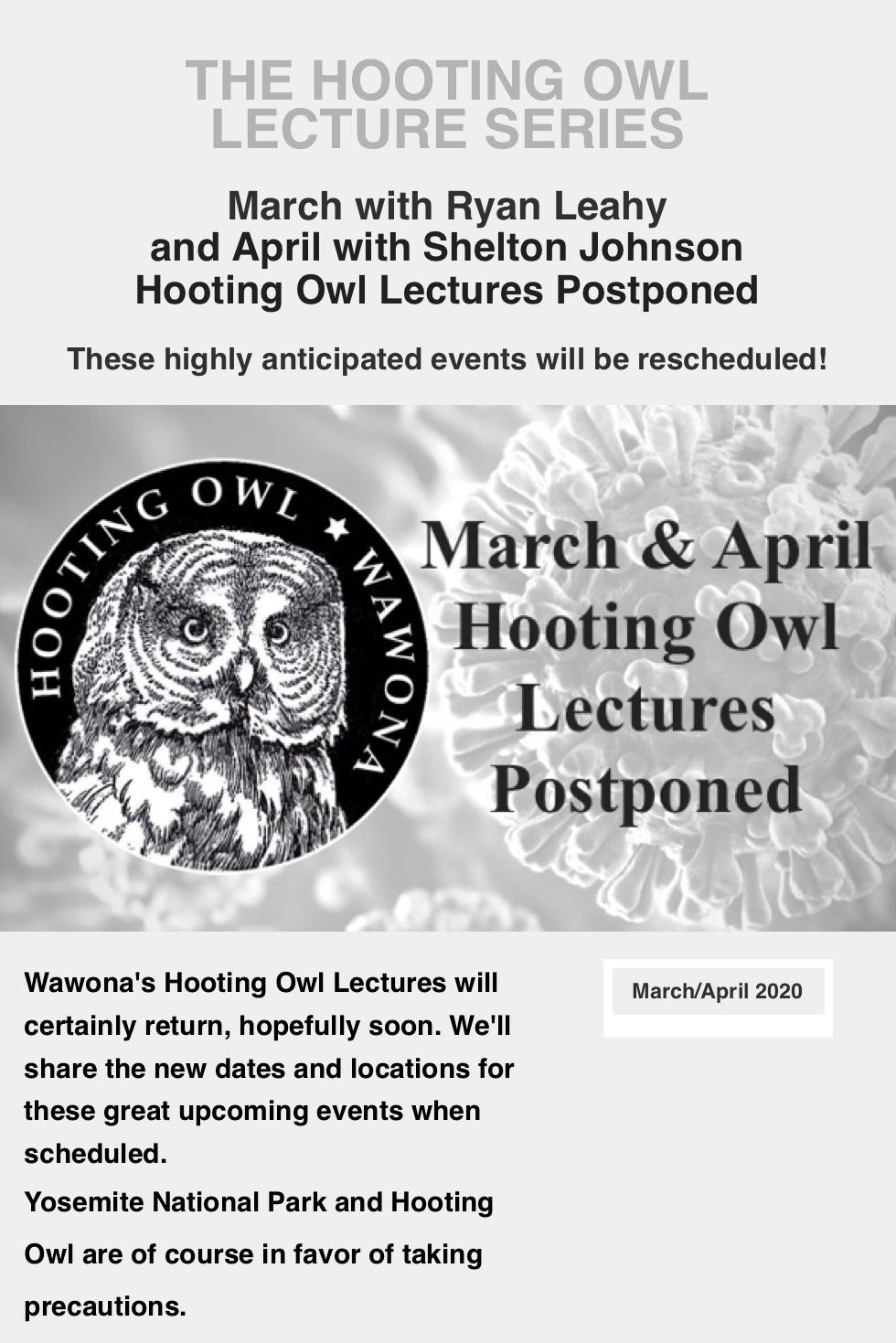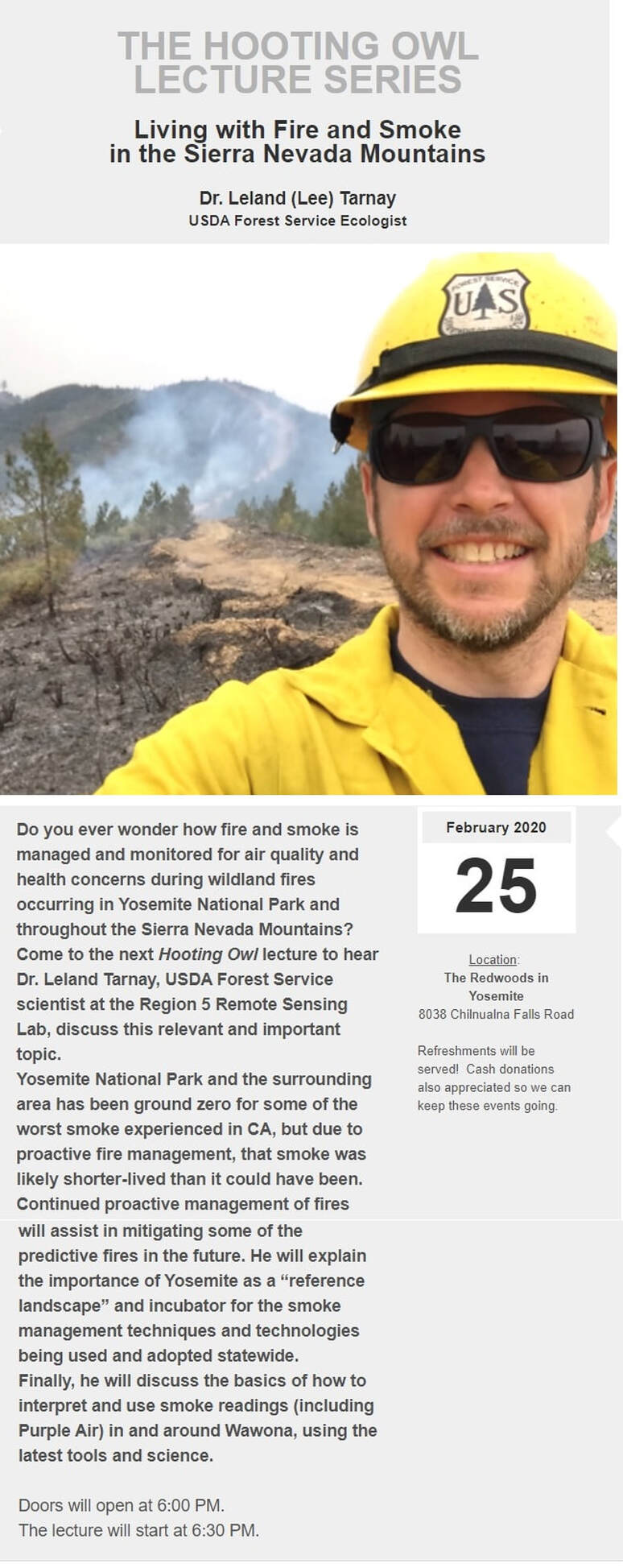WawonaNews.com - March 2020
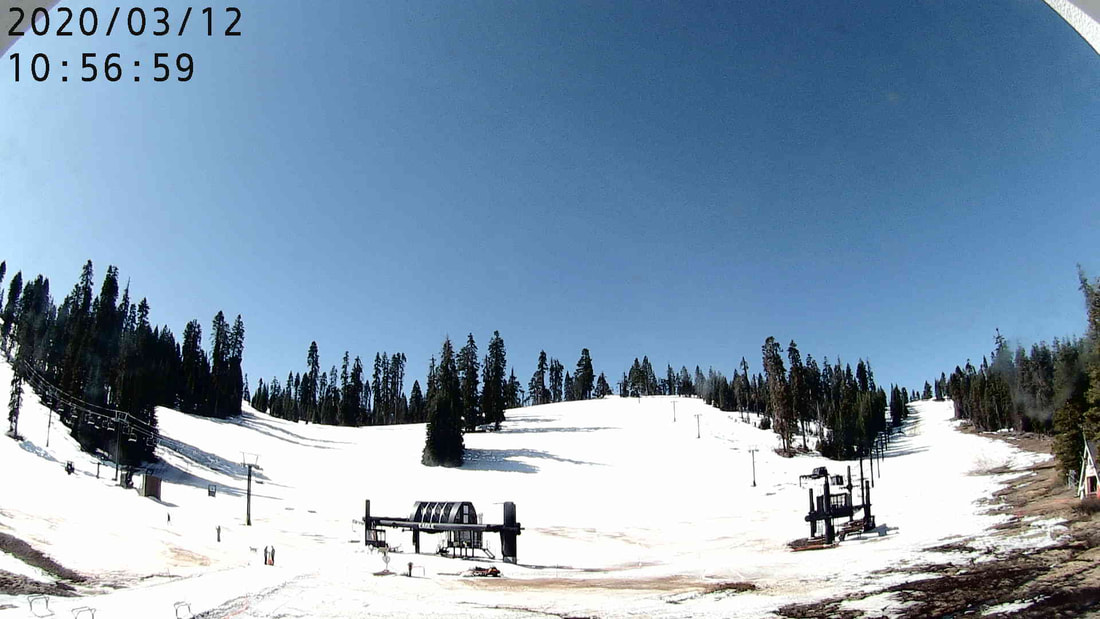
Badger Pass Ski Area is Closed for the Season 3/12/2020
Badger Pass Ski Area is now closed for the season due to conditions. There will be staff at the ski area through Sunday 3/15 for skiers/snowboarders to retrieve items from season lockers. Our “Early Bird Season Pass offer” for the 2020-21 season is now available at www.TravelYosemite.com Thank you everyone for a great season. (L. Cesaro)
Badger Pass Ski Area is now closed for the season due to conditions. There will be staff at the ski area through Sunday 3/15 for skiers/snowboarders to retrieve items from season lockers. Our “Early Bird Season Pass offer” for the 2020-21 season is now available at www.TravelYosemite.com Thank you everyone for a great season. (L. Cesaro)
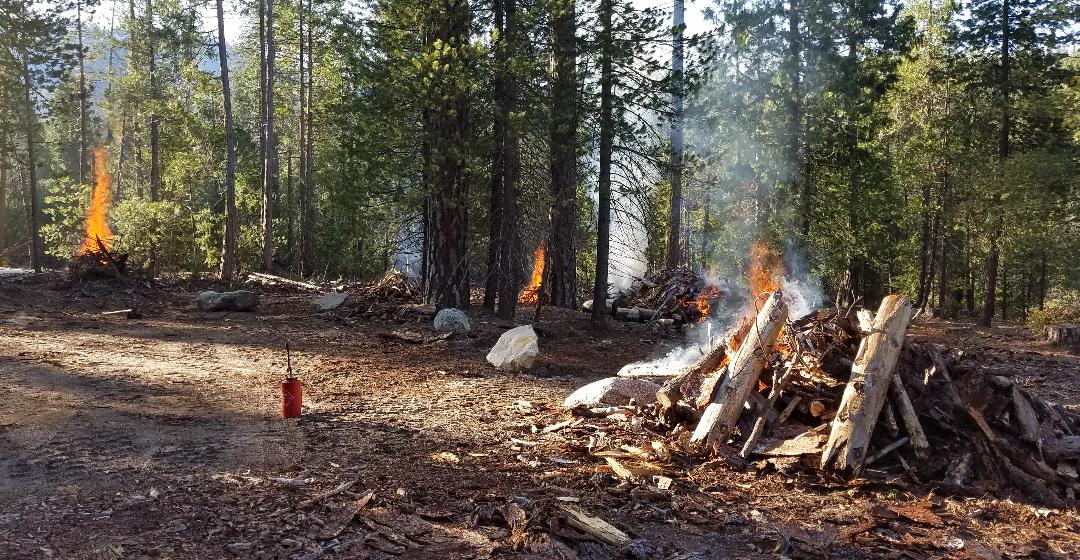
Spring Prescribed Fire and Fuels Projects
Yosemite National Park has begun preparations for spring prescribed fire and fuels projects. 50 years of research has taught park managers that suppressing all fires results in unnatural fuel buildup and only delays the inevitable, which can make fires more severe than they otherwise would have been. Prescribed fire and fuels reduction projects are important tools for reducing excessive vegetation build up on the landscape in order to reduce the severity of future fires.
Crane Flat Prescribed Fire
Yosemite fire crews are continuing preparation for a prescribed fire near Crane Flat lookout between the Tioga Road and Big Oak Flat Road. Planned ignitions are for Units A-D for a total of 670 acres. Ignitions will consist of hand firing with drip torches, as well as aerial firing utilizing a helicopter and plastic sphere dispenser (PSD) machine.
The exact ignition date of this prescribed fire depends on a crucial mixture of weather, fuels moistures, and firefighter availability.
Smoke impacts will be localized to the Crane Flat area during the day. However, transient smoke will likely drift down canyon during the evening hours.
Pile Burning
Pile burning will continue throughout the park as conditions allow. Burning piles is an efficient and effective way for reducing excessive fuel build-up on the landscape. These piles are remnants of mechanical thinning from forestry operations and large-scale landscape restoration projects throughout the park. Most of the burning will take place in Yosemite Valley and the community of Wawona. Smoke from ignited piles will remain until the piles are completely consumed.
Fuels Projects
Fire personnel are currently working in the community of Wawona on the Section 35 fuels project. This project is on-going and will mainly consist of cutting dead and down vegetation with chainsaws then piling it for future burning. You may see fuels crews and heavy equipment near residences, please use caution in these areas.
Smoke
Smoke will be present during prescribed fire operations. However, smoke produced during a prescribed fire is significantly less than if an unwanted wildfire occurs.
Yosemite National Park works closely with park air quality specialists to calculate how much smoke may be produced based on the vegetation (fuel) type, number of acres, and meteorological conditions. Particulate monitors are placed in areas that may see impacts of smoke during certain hours of the day.
Fire managers work closely with local air pollution control districts to time the projects to coincide with favorable weather and smoke dispersion conditions. Smoke impacts are always a consideration in the decision to begin prescribed fire ignitions. A smoke management plan will be submitted, and a burn permit will be issued for Crane Flat.
Spring Prescribed Fire and Fuels Projects 2020
NPS Photo: Pile burning at Swinging Bridge trail head at the end of Chilnualna Falls Road in Wawona.
For information planning your visit in Yosemite National Park visit : www.nps.gov/yose
For information about Yosemite National Park's Fire Program visit: go.nps.gov/yosefire
For information about air quality in Yosemite National Park www.nps.gov/yose/learn/nature/aqmonitoring
-NPS-
Yosemite National Park has begun preparations for spring prescribed fire and fuels projects. 50 years of research has taught park managers that suppressing all fires results in unnatural fuel buildup and only delays the inevitable, which can make fires more severe than they otherwise would have been. Prescribed fire and fuels reduction projects are important tools for reducing excessive vegetation build up on the landscape in order to reduce the severity of future fires.
Crane Flat Prescribed Fire
Yosemite fire crews are continuing preparation for a prescribed fire near Crane Flat lookout between the Tioga Road and Big Oak Flat Road. Planned ignitions are for Units A-D for a total of 670 acres. Ignitions will consist of hand firing with drip torches, as well as aerial firing utilizing a helicopter and plastic sphere dispenser (PSD) machine.
The exact ignition date of this prescribed fire depends on a crucial mixture of weather, fuels moistures, and firefighter availability.
Smoke impacts will be localized to the Crane Flat area during the day. However, transient smoke will likely drift down canyon during the evening hours.
Pile Burning
Pile burning will continue throughout the park as conditions allow. Burning piles is an efficient and effective way for reducing excessive fuel build-up on the landscape. These piles are remnants of mechanical thinning from forestry operations and large-scale landscape restoration projects throughout the park. Most of the burning will take place in Yosemite Valley and the community of Wawona. Smoke from ignited piles will remain until the piles are completely consumed.
Fuels Projects
Fire personnel are currently working in the community of Wawona on the Section 35 fuels project. This project is on-going and will mainly consist of cutting dead and down vegetation with chainsaws then piling it for future burning. You may see fuels crews and heavy equipment near residences, please use caution in these areas.
Smoke
Smoke will be present during prescribed fire operations. However, smoke produced during a prescribed fire is significantly less than if an unwanted wildfire occurs.
Yosemite National Park works closely with park air quality specialists to calculate how much smoke may be produced based on the vegetation (fuel) type, number of acres, and meteorological conditions. Particulate monitors are placed in areas that may see impacts of smoke during certain hours of the day.
Fire managers work closely with local air pollution control districts to time the projects to coincide with favorable weather and smoke dispersion conditions. Smoke impacts are always a consideration in the decision to begin prescribed fire ignitions. A smoke management plan will be submitted, and a burn permit will be issued for Crane Flat.
Spring Prescribed Fire and Fuels Projects 2020
NPS Photo: Pile burning at Swinging Bridge trail head at the end of Chilnualna Falls Road in Wawona.
For information planning your visit in Yosemite National Park visit : www.nps.gov/yose
For information about Yosemite National Park's Fire Program visit: go.nps.gov/yosefire
For information about air quality in Yosemite National Park www.nps.gov/yose/learn/nature/aqmonitoring
-NPS-
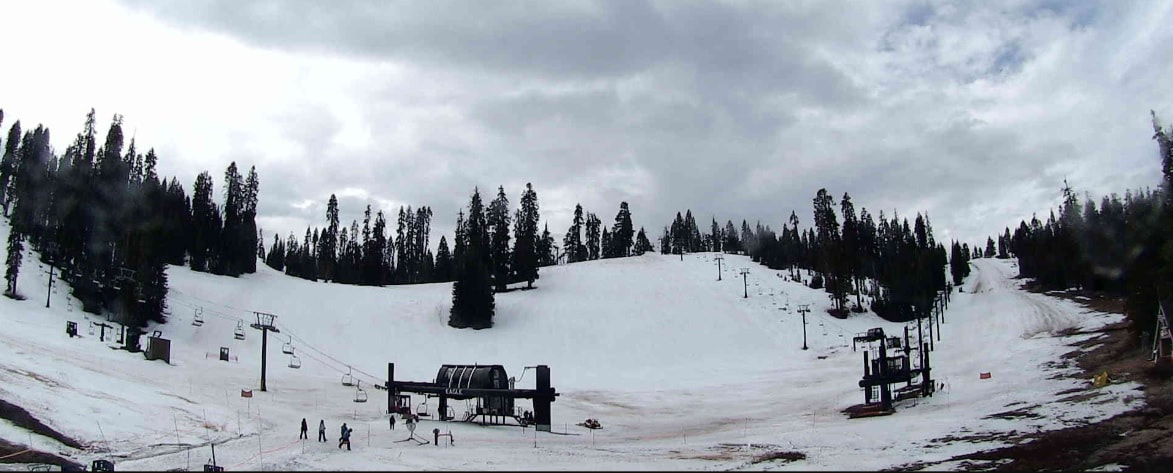
Badger Pass Closing March 15
Badger Pass Ski Area is scheduled to close after operations on Sunday, March 15th due to lack of snow. Skiers/snowboarders should plan to vacate their season lockers by 3/15. If there are any changes, we will share more information. Get your last skiing/riding in for the season! (L. Cesaro)
Badger Pass Ski Area is scheduled to close after operations on Sunday, March 15th due to lack of snow. Skiers/snowboarders should plan to vacate their season lockers by 3/15. If there are any changes, we will share more information. Get your last skiing/riding in for the season! (L. Cesaro)
Wawona Pile Burning Update
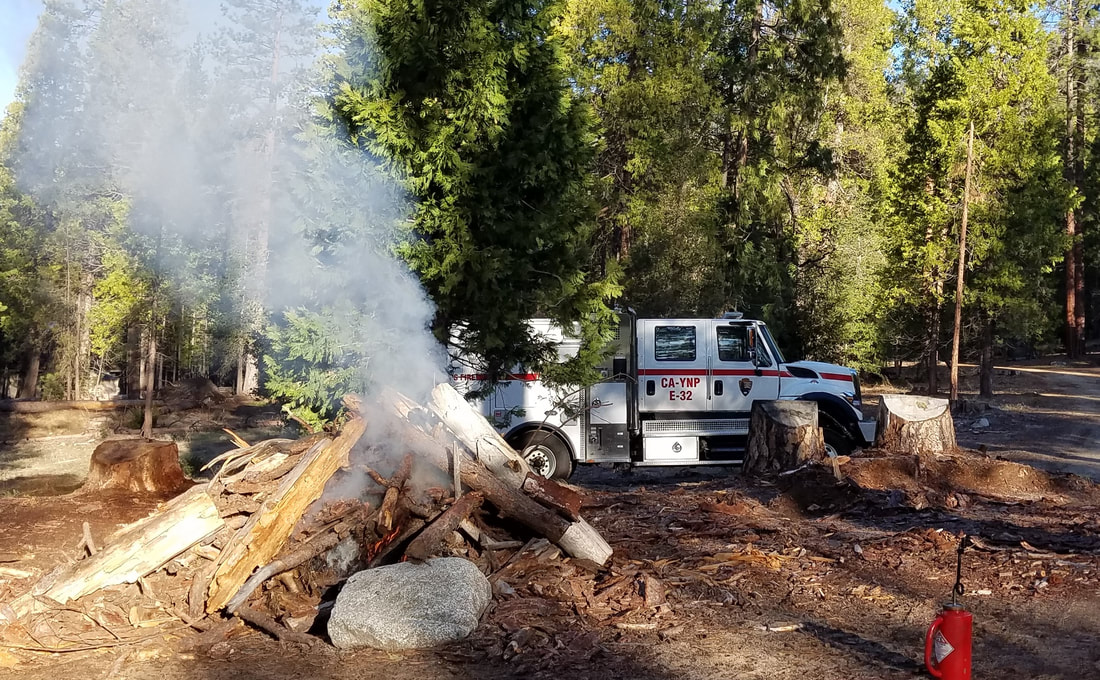 NPS Photo Taken by S. Saunders March 9th, 2020 Engine 32 burning piles near Swinging Bridge Trailhead
NPS Photo Taken by S. Saunders March 9th, 2020 Engine 32 burning piles near Swinging Bridge Trailhead
Yosemite firefighters have resumed working on fuels projects throughout the park especially in Wawona, on the Section 35 fuels project. The focus this last week was near the end of Chilnualna Falls road near the Chilnaualna Falls trailhead and Swinging Bridge trailhead. With precipitation in the forecast firefighters started burning piles at the end of Chilnualna Falls near the Swinging Bridge parking area then working their way back towards the bridge. This project focuses on cleaning up dense dead and down ground fuels left by past forestry operations. Pile burning is a very efficient and effective tool for reducing the excessive amount of fuel on the landscape. It helps restore wild and scenic vistas, create a resilient forest ecosystem, and protect cultural resources as well as infrastructure. Smoke will be present until piles are completely consumed. Firefighters are on site monitoring piles and work hard to make sure each pile consumes before leaving them. The park works closely with the air resource district on ignition and timing of pile burning operations.
We would like to thank the community of Wawona for their continued support in helping us become a firewise community. Don’t be afraid to talk to us. If you have any questions about these projects, please send an email to [email protected]
For information about the parks fire management program please go to: go.nps.gov/yosefire
For information about air quality in Yosemite National Park: https://www.nps.gov/yose/learn/nature/aqmonitoring.htm
Shanelle Saunders
Fire Communication and Education Specialist
Fire Information Officer
Yosemite National Park
C: 209-347-6395
M-Th: 0730-1800
go.nps.gov/yosefire
We would like to thank the community of Wawona for their continued support in helping us become a firewise community. Don’t be afraid to talk to us. If you have any questions about these projects, please send an email to [email protected]
For information about the parks fire management program please go to: go.nps.gov/yosefire
For information about air quality in Yosemite National Park: https://www.nps.gov/yose/learn/nature/aqmonitoring.htm
Shanelle Saunders
Fire Communication and Education Specialist
Fire Information Officer
Yosemite National Park
C: 209-347-6395
M-Th: 0730-1800
go.nps.gov/yosefire
Cameras Spot a Rare Fisher Roaming Yosemite
BY DAVID CARACCIO - Sacramento Bee
Biologists this winter confirmed the rare sighting of a fisher living in the habitat north of Merced River in Yosemite National Park.
The fisher is a “very rare and secretive member of the weasel family,” Yosemite National Park said in a news release.
Biologists used motion-sensor cameras, scent-detecting dogs and genetic analysis to confirmed two fisher scats and four fisher pictures. That means there could be from one to six fishers living in the southern Sierra Nevada area.
The last fisher detected north of the Merced River was in 2017, the first time in almost 100 years. Biologists collared and tracked the animal to study its habitat needs, but after the collar battery died, the fate of the fisher became unknown. The mystery may be solved soon.
“We hope to learn through DNA genotyping if any of the recent detections match the DNA of the fisher that was captured and collared in 2017,” Yosemite National Park said in a Feb. 22 Facebook post.
Fishers were once widespread in North America, but their numbers dwindled in the 1800s as hunters sought out their soft fur, according to the Sierra Club. Their numbers never completely recovered despite a California trapping ban in the 1940s. Logging, development and wildfires further helped decrease the fisher population.
The fisher research is a collaboration between Yosemite National Park, US Forest Service, Rogue Detection Dog Teams, U.C. Davis, and Oregon State University.
Biologists this winter confirmed the rare sighting of a fisher living in the habitat north of Merced River in Yosemite National Park.
The fisher is a “very rare and secretive member of the weasel family,” Yosemite National Park said in a news release.
Biologists used motion-sensor cameras, scent-detecting dogs and genetic analysis to confirmed two fisher scats and four fisher pictures. That means there could be from one to six fishers living in the southern Sierra Nevada area.
The last fisher detected north of the Merced River was in 2017, the first time in almost 100 years. Biologists collared and tracked the animal to study its habitat needs, but after the collar battery died, the fate of the fisher became unknown. The mystery may be solved soon.
“We hope to learn through DNA genotyping if any of the recent detections match the DNA of the fisher that was captured and collared in 2017,” Yosemite National Park said in a Feb. 22 Facebook post.
Fishers were once widespread in North America, but their numbers dwindled in the 1800s as hunters sought out their soft fur, according to the Sierra Club. Their numbers never completely recovered despite a California trapping ban in the 1940s. Logging, development and wildfires further helped decrease the fisher population.
The fisher research is a collaboration between Yosemite National Park, US Forest Service, Rogue Detection Dog Teams, U.C. Davis, and Oregon State University.
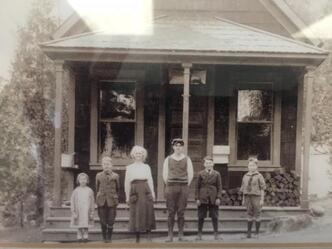
YOSEMITE-WAWONA ELEMENTARY CHARTER SCHOOL
Board of Directors Regular Meeting
Tuesday, March 10, 2020
5:30 P.M.
Wawona Elementary School
7925 Chilnualana Falls Road
Wawona, CA
MONTHLY ITEMS AND FINANCIAL REPORTS
3.1- Approval of Agenda
3.2– Approval of Minutes of the regular meeting of February 11, 2020
3.3–Approve Payroll
3.4- Approve Warrants
3.5 -Accept Donations to YWECS
ACTION ITEMS
INFORMATION ITEMS
Note* - this is during the Easter Break. The Board might consider moving the meeting date
Board of Directors Regular Meeting
Tuesday, March 10, 2020
5:30 P.M.
Wawona Elementary School
7925 Chilnualana Falls Road
Wawona, CA
- CALL TO ORDER
- ROLL CALL
MONTHLY ITEMS AND FINANCIAL REPORTS
- CONSENT AGENDA
3.1- Approval of Agenda
3.2– Approval of Minutes of the regular meeting of February 11, 2020
3.3–Approve Payroll
3.4- Approve Warrants
3.5 -Accept Donations to YWECS
- HEARING OF PERSONS WISHING TO ADDRESS THE BOARD
ACTION ITEMS
- APPROVAL OF CALENDAR FOR 2020-21 SCHOOL YEAR
- APPROVAL OF 2ND INTERIM BUDGET REPORT
- APPROVAL OF FORM 990 TAX FILING
- APPROVAL OF COMPREHENSIVE SCHOOL SAFETY PLAN
- SELECTION OF AN INDEPENDENT AUDIT FIRM FOR THER 2019-20 SCHOOL YEAR
- ADDITION OF A NEW YWECS BOARD MEMBER
- APPROVAL OF AN EMPLOYEE REIMBURSEMENT FORM
INFORMATION ITEMS
- FUNDRAISING EVENTS
- STUDENT ENROLLMENT FOR 2020-21
- STAFF REPORTS
- BOARD MEMBER COMMENTS
- FUTURE AGENDA ITEMS
- NEXT BOARD MEETING
Note* - this is during the Easter Break. The Board might consider moving the meeting date
- CLOSED SESSION: Personnel/Negotiations/Litigation
- Personnel (Gov. Code 54957)
- RECONVENE IN OPEN SESSION: Announce Closed Session Actions
- ADJOURNMENT
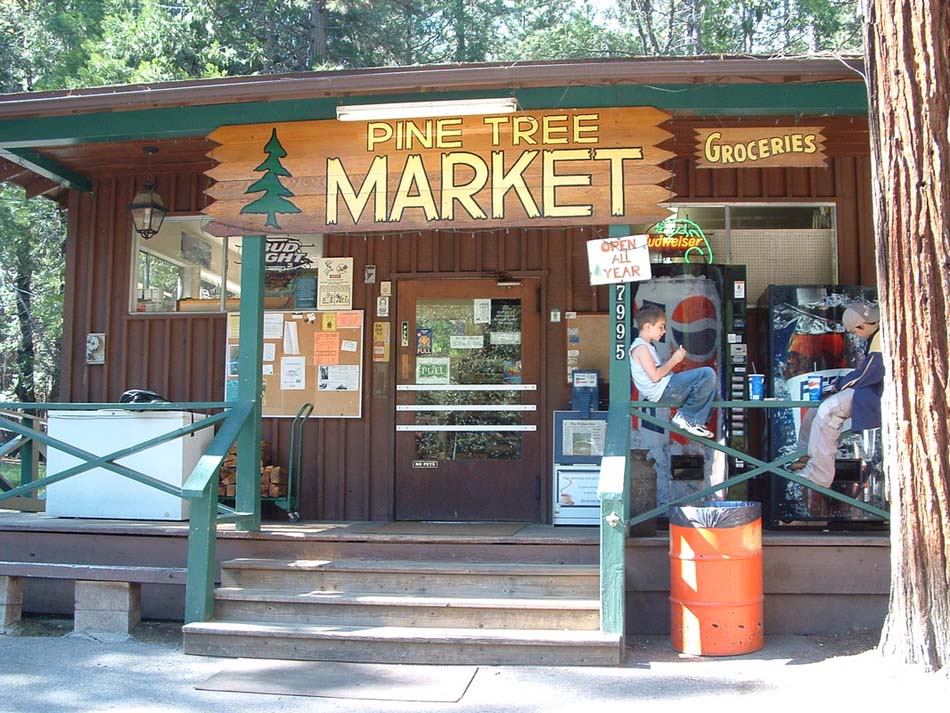
Our Beloved Pine Tree Market Changes Ownership
The Wawona Pine Tree Market has new owners and Peter LeCompte has written a public "thanks" to Paul De Santis for all these years, which accurately represents the community's feelings. Thanks, Peter, and thanks Paul for making The Pine Tree Market our favorite store anywhere!
PAUL!
Pine Tree.
I have been heralding the Pine Tree market for decades. When I have hauled family and friends to the cabin, a TRUCKLOAD of food , well -planned? I have always forgotten one thing. One random thing/
Pine Tree!
Capers, nice avocados, green onions, can of cream-O-mushroom soup for a casserole? Box of truly sweet corn in summertime? On the porch/on ice? Good hooch? Fantastic “WAWONA” sweatshirts? Ribeye steak, DVD’s, his tiny market has been a lifesaver. And Josh, and their kids.
Just giving thanks, we are on the ‘other’ side of the river, but always came around to hit Pine Tree. Even making the kids crawl across the river with 7$ for ice cream treats.
So. Thanks Paul and Josh, for the help and memories and a WAWONA institution!
Hope it’s continued.
Love to all.
Peter LeCompte
The Wawona Pine Tree Market has new owners and Peter LeCompte has written a public "thanks" to Paul De Santis for all these years, which accurately represents the community's feelings. Thanks, Peter, and thanks Paul for making The Pine Tree Market our favorite store anywhere!
PAUL!
Pine Tree.
I have been heralding the Pine Tree market for decades. When I have hauled family and friends to the cabin, a TRUCKLOAD of food , well -planned? I have always forgotten one thing. One random thing/
Pine Tree!
Capers, nice avocados, green onions, can of cream-O-mushroom soup for a casserole? Box of truly sweet corn in summertime? On the porch/on ice? Good hooch? Fantastic “WAWONA” sweatshirts? Ribeye steak, DVD’s, his tiny market has been a lifesaver. And Josh, and their kids.
Just giving thanks, we are on the ‘other’ side of the river, but always came around to hit Pine Tree. Even making the kids crawl across the river with 7$ for ice cream treats.
So. Thanks Paul and Josh, for the help and memories and a WAWONA institution!
Hope it’s continued.
Love to all.
Peter LeCompte
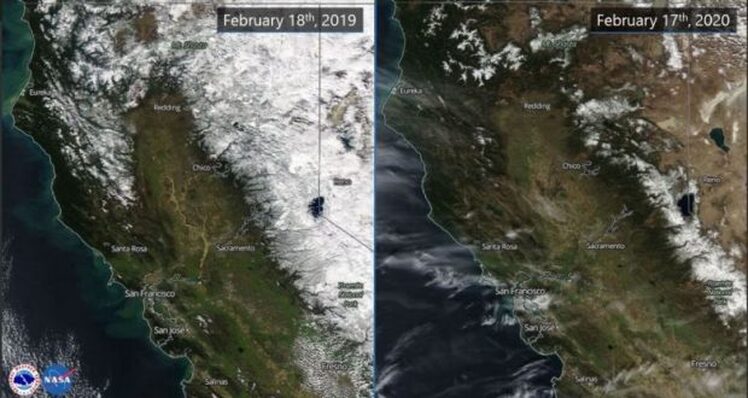
Forecasters: Low Sierra Snow Pack Could Mean Early Start to Fire Season
Posted by: SNO Staff February 22, 2020
MOUNTAIN COMMUNITIES — NASA satellite images taken this past week from more than 400 miles above Earth show snow pack levels in the Sierras at just 54 percent of their historical average for this time of the year.
The most recent data is sparking concerns that parts of California are slipping back into a drought — and that the 2020 fire season could begin much sooner.
“Forested areas, especially those with a lot of dead trees, will dry out much sooner without as much snow pack or runoff when the warmer weather comes,” warned one fire official. “We could be looking at a very active 2020 fire season in the Sierra.”
The recent NASA photos provide a clear indication of how much less snow has fallen over the Sierras this winter compared to last. At this time in 2019, the Sierra snow pack was at 147 percent of its historical average, according to the National Weather Service.
The satellite images captured last week show the northern Sierra is currently at 58 percent of its historical average while central Sierra snow pack levels, which include Madera and Mariposa counties, is at 54 percent of the historical average and the southern Sierra currently sits at just 49 percent of average.
With six weeks still remaining in California’s traditional winter season, forecasters say any new storms, especially heavy ones, could boost the snow pack totals closer to annual averages.
But as of this week, forecasts are calling for the dry weather to continue through the end of February across much of the state.
“What a difference a year makes!” forecasters at the National Weather Service in Sacramento said on Twitter while posting the most recent satellite images.
According to the U.S. Drought Monitor, less than half of normal precipitation has fallen from central and southern Nevada westward across most of California since mid-December. Last week, just under 10 percent of the state, including the central and southern Sierras and adjacent areas of the Central Valley, was designated as being back in “moderate” drought conditions.
After a wet December, many parts of the Sierra are seeing their driest combined January and February on record, forecasters say.
The California Department of Water Resources took its most recent Sierra snow pack measurements on Feb. 20. The next snow pack measurement date is scheduled for April 1.
Posted by: SNO Staff February 22, 2020
MOUNTAIN COMMUNITIES — NASA satellite images taken this past week from more than 400 miles above Earth show snow pack levels in the Sierras at just 54 percent of their historical average for this time of the year.
The most recent data is sparking concerns that parts of California are slipping back into a drought — and that the 2020 fire season could begin much sooner.
“Forested areas, especially those with a lot of dead trees, will dry out much sooner without as much snow pack or runoff when the warmer weather comes,” warned one fire official. “We could be looking at a very active 2020 fire season in the Sierra.”
The recent NASA photos provide a clear indication of how much less snow has fallen over the Sierras this winter compared to last. At this time in 2019, the Sierra snow pack was at 147 percent of its historical average, according to the National Weather Service.
The satellite images captured last week show the northern Sierra is currently at 58 percent of its historical average while central Sierra snow pack levels, which include Madera and Mariposa counties, is at 54 percent of the historical average and the southern Sierra currently sits at just 49 percent of average.
With six weeks still remaining in California’s traditional winter season, forecasters say any new storms, especially heavy ones, could boost the snow pack totals closer to annual averages.
But as of this week, forecasts are calling for the dry weather to continue through the end of February across much of the state.
“What a difference a year makes!” forecasters at the National Weather Service in Sacramento said on Twitter while posting the most recent satellite images.
According to the U.S. Drought Monitor, less than half of normal precipitation has fallen from central and southern Nevada westward across most of California since mid-December. Last week, just under 10 percent of the state, including the central and southern Sierras and adjacent areas of the Central Valley, was designated as being back in “moderate” drought conditions.
After a wet December, many parts of the Sierra are seeing their driest combined January and February on record, forecasters say.
The California Department of Water Resources took its most recent Sierra snow pack measurements on Feb. 20. The next snow pack measurement date is scheduled for April 1.
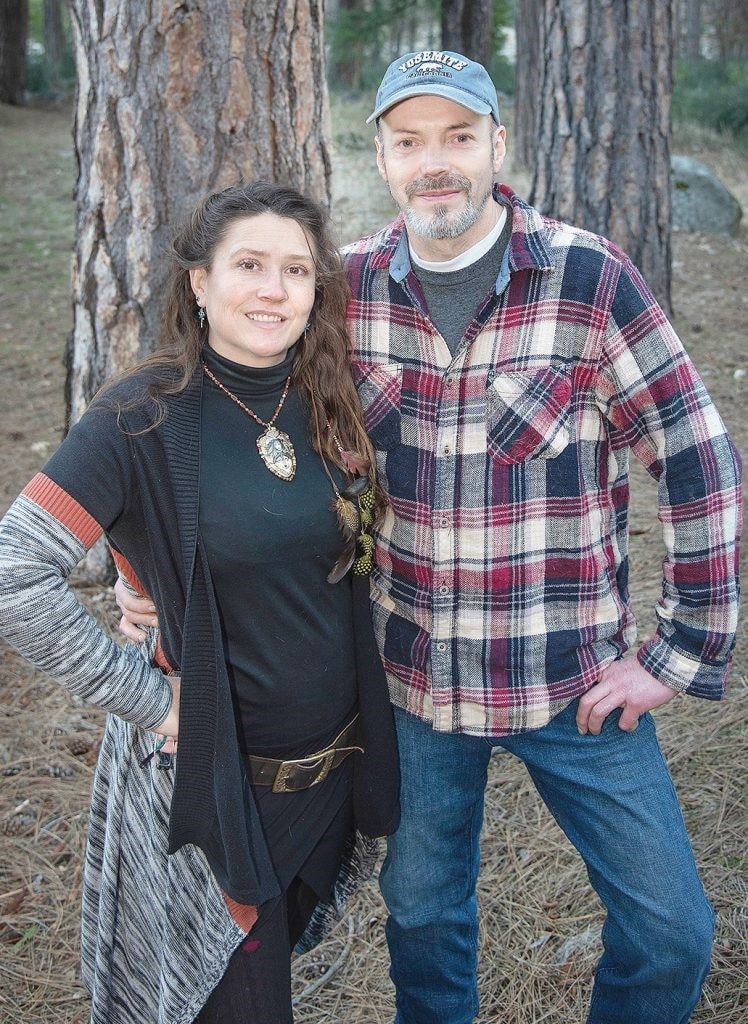
History Abounds at Famous Camp in The Heart of Wawona
|
Manager Margina Jones and third generation owner Garth May are shown at Camp Chilnualna Cabins in 2020.
February 20, 2020
By KELLIE FLANAGAN
Gazette correspondent
Eighteen miles east of Mariposa as the crow flies, inside Yosemite National Park, is the town of Wawona: once a busy stage stop en route to the valley floor and beyond. Famously known as home to one of the oldest mountain resorts in California, the settlement’s existence precedes the founding of the national recreation area surrounding it, a designation that created a cushion of Yosemite on which shines the jewel of Wawona.
“Growing up here was amazing and wonderful,” according to Garth May, the third generation of his family to live in Wawona as owners of Camp Chilnualna Cabins, originally established by Albert Spelt in 1920 and now celebrating its 100th year in vacation rentals and recreation.
Today, Camp Chilnualna consists of six charmingly rustic cabins on about four-and-a-half acres of stunning land near the south fork of the Merced River, plus the May family home. Nearby are the Pine Tree Market, an elementary school, a library, some research stations and about 400 homes, mostly cabins and cottages. The majority of those are vacation homes and rentals; Wawona has about 160 full-time residents, but with millions of people coming to Yosemite every year, the number of visitors is infinitely higher — and for good reason.
|
Manager Margina Jones and third generation owner Garth May are shown at Camp Chilnualna Cabins in 2020.
February 20, 2020
By KELLIE FLANAGAN
Gazette correspondent
Eighteen miles east of Mariposa as the crow flies, inside Yosemite National Park, is the town of Wawona: once a busy stage stop en route to the valley floor and beyond. Famously known as home to one of the oldest mountain resorts in California, the settlement’s existence precedes the founding of the national recreation area surrounding it, a designation that created a cushion of Yosemite on which shines the jewel of Wawona.
“Growing up here was amazing and wonderful,” according to Garth May, the third generation of his family to live in Wawona as owners of Camp Chilnualna Cabins, originally established by Albert Spelt in 1920 and now celebrating its 100th year in vacation rentals and recreation.
Today, Camp Chilnualna consists of six charmingly rustic cabins on about four-and-a-half acres of stunning land near the south fork of the Merced River, plus the May family home. Nearby are the Pine Tree Market, an elementary school, a library, some research stations and about 400 homes, mostly cabins and cottages. The majority of those are vacation homes and rentals; Wawona has about 160 full-time residents, but with millions of people coming to Yosemite every year, the number of visitors is infinitely higher — and for good reason.
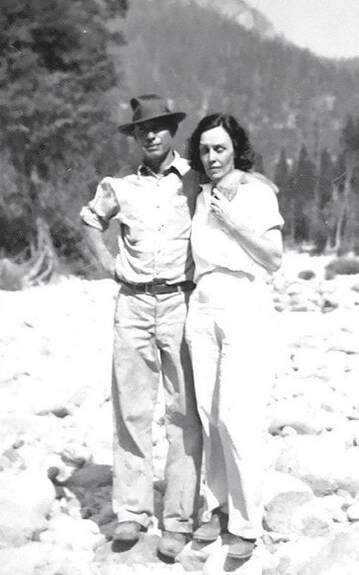
“Wawona is just perfect in so many ways,” Garth continued, expressing his love for the little neighborhood tucked inside the park at an elevation of 4,000 feet. “It’s the perfect weather, we just get four nice seasons and I never get tired of this place.”
Named for nearby falls tumbling dramatically hundreds of feet over granite, Chinualna (chill-new-all-na) is said to mean “echos of the waters,” in the first people’s language.
The long haul
The May family has been at the helm here since the mid-30s when then-owner Cornelia McBeth Wooster sold the property —including the Camp Chinualna cottages — to Garth May’s grandfather Harold May, when Garth’s dad Norman was just a kid.
Norman attended the one-room elementary school in Wawona from the time it first opened, book-ended by Garth and his older sister, Terry, who went to class there until the original school closed for a time in the 1970s. Coming of age in Wawona meant living under towering trees, summers spent jumping endlessly into the river and keeping the occasional orphaned deer as a treasured family “pet.”
Much has been written about the pioneering families of early Wawona and the history of each is fascinating to learn. The May family’s presence in the area dates back almost 90 years to when Garth’s grandpa Harold May first helped build the road on which millions of people now enter Yosemite National Park every year.
Harold and Edna May purchased Camp Chilnualna
for $6,500 during the Great Depression.
Photo courtesy of Garth May
Named for nearby falls tumbling dramatically hundreds of feet over granite, Chinualna (chill-new-all-na) is said to mean “echos of the waters,” in the first people’s language.
The long haul
The May family has been at the helm here since the mid-30s when then-owner Cornelia McBeth Wooster sold the property —including the Camp Chinualna cottages — to Garth May’s grandfather Harold May, when Garth’s dad Norman was just a kid.
Norman attended the one-room elementary school in Wawona from the time it first opened, book-ended by Garth and his older sister, Terry, who went to class there until the original school closed for a time in the 1970s. Coming of age in Wawona meant living under towering trees, summers spent jumping endlessly into the river and keeping the occasional orphaned deer as a treasured family “pet.”
Much has been written about the pioneering families of early Wawona and the history of each is fascinating to learn. The May family’s presence in the area dates back almost 90 years to when Garth’s grandpa Harold May first helped build the road on which millions of people now enter Yosemite National Park every year.
Harold and Edna May purchased Camp Chilnualna
for $6,500 during the Great Depression.
Photo courtesy of Garth May
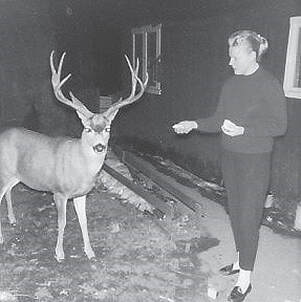
“In 1933 a company called Granite Construction was building Highway 41 from Yosemite all the way down to the coast, and my grandfather was on that crew building the highway,” Garth said.
Born in 1900, by the 1930s his grandfather Harold May was a rock-crusher on the crew, moving around to different towns with his wife, Edna, as the new road carried them. Born and raised in the rough mining camps of Montana, Edna was well suited to an adventurous life with Harold and, even while living at the coast, they never forgot the time they spent in Wawona.
Pat May is shown with mule deer buck Bambi, whom they fostered after he was abandoned at Camp Chilnualna. Photo courtesy of Garth May
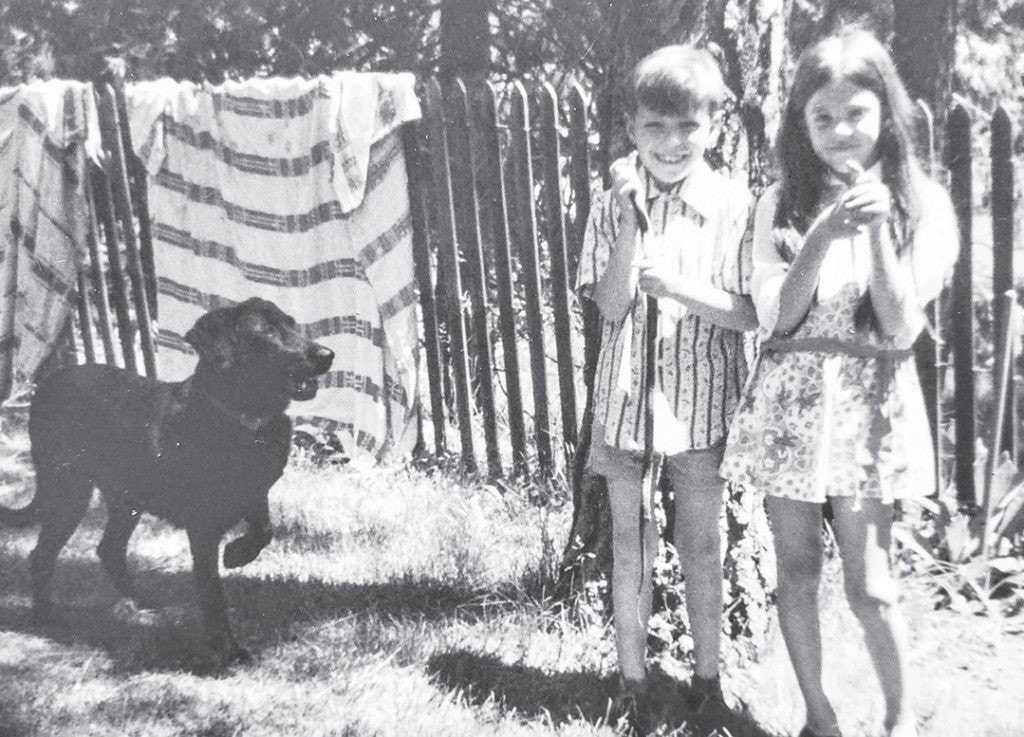
Garth May and slightly older sister Terri pose with catch and release reptiles at Camp Chilnualna when they were kids. Photo courtesy of Garth May
So, when it came time to settle with their son and daughter, the Mays “did what folks did back then,” said Garth, and “just jumped in the car with everything and came up here.”
They paid $6,500 to purchase Camp Chilnualna — which included a small store at the time — right in the middle of the Great Depression.“Times were hard in those days,” wrote Garth’s father Norman May much later in life, looking back on his childhood in an unpublished memoir. “The depression was at its peak and sometimes [my] parents wondered if they had done the right thing by purchasing Camp Chilnualna, but they loved the place and they struggled on.”
So, when it came time to settle with their son and daughter, the Mays “did what folks did back then,” said Garth, and “just jumped in the car with everything and came up here.”
They paid $6,500 to purchase Camp Chilnualna — which included a small store at the time — right in the middle of the Great Depression.“Times were hard in those days,” wrote Garth’s father Norman May much later in life, looking back on his childhood in an unpublished memoir. “The depression was at its peak and sometimes [my] parents wondered if they had done the right thing by purchasing Camp Chilnualna, but they loved the place and they struggled on.”
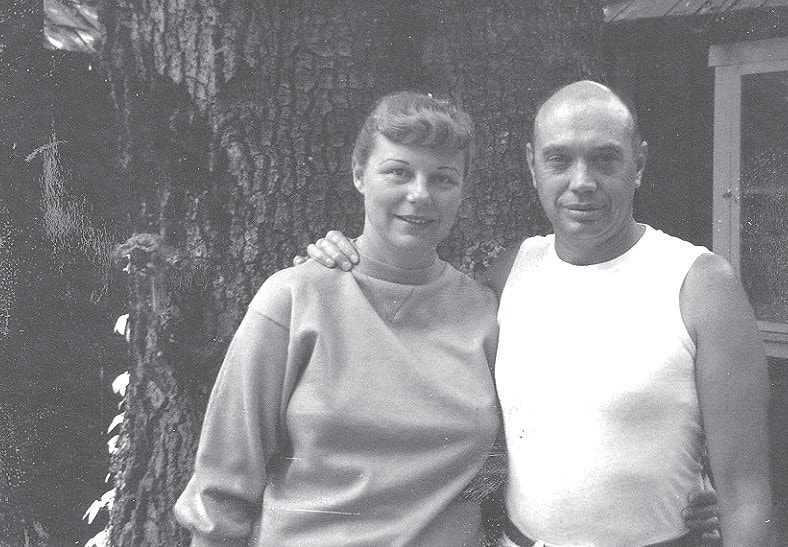
Pat and Norman May married at Sentinel Dome in Yosemite about a year after Edna died in 1960 and Pat pitched in to help at the camp. Photo courtesy of Garth May
To make matters worse, he chronicled, “the heaviest and coldest winter in the memory of the white man arrived during the winter of 1936-37. The official measurement of snowfall was 16 feet of snow in six weeks, settling to a hard pack of six feet of ‘Sierra cement.’ The temperature dropped to -28 degrees at Camp Chilnualna.”
To war and back
By that time, Harold had gone to work for the park and was plowing snow without a break for 52-cents an hour. That freezing winter was followed by the Great Flood of 1937-38, which came over Christmas and New Year when Norman was a young teen.
By the 1940s the Great Depression had run its course, but World War II was calling men across the United States to battle, including Norman May.
“At 17 he threatened to run away from home if his mom and dad didn’t sign his permission to join the Marines and fight in World War II,” Garth recounted of his dad’s determination to enlist.
To make matters worse, he chronicled, “the heaviest and coldest winter in the memory of the white man arrived during the winter of 1936-37. The official measurement of snowfall was 16 feet of snow in six weeks, settling to a hard pack of six feet of ‘Sierra cement.’ The temperature dropped to -28 degrees at Camp Chilnualna.”
To war and back
By that time, Harold had gone to work for the park and was plowing snow without a break for 52-cents an hour. That freezing winter was followed by the Great Flood of 1937-38, which came over Christmas and New Year when Norman was a young teen.
By the 1940s the Great Depression had run its course, but World War II was calling men across the United States to battle, including Norman May.
“At 17 he threatened to run away from home if his mom and dad didn’t sign his permission to join the Marines and fight in World War II,” Garth recounted of his dad’s determination to enlist.
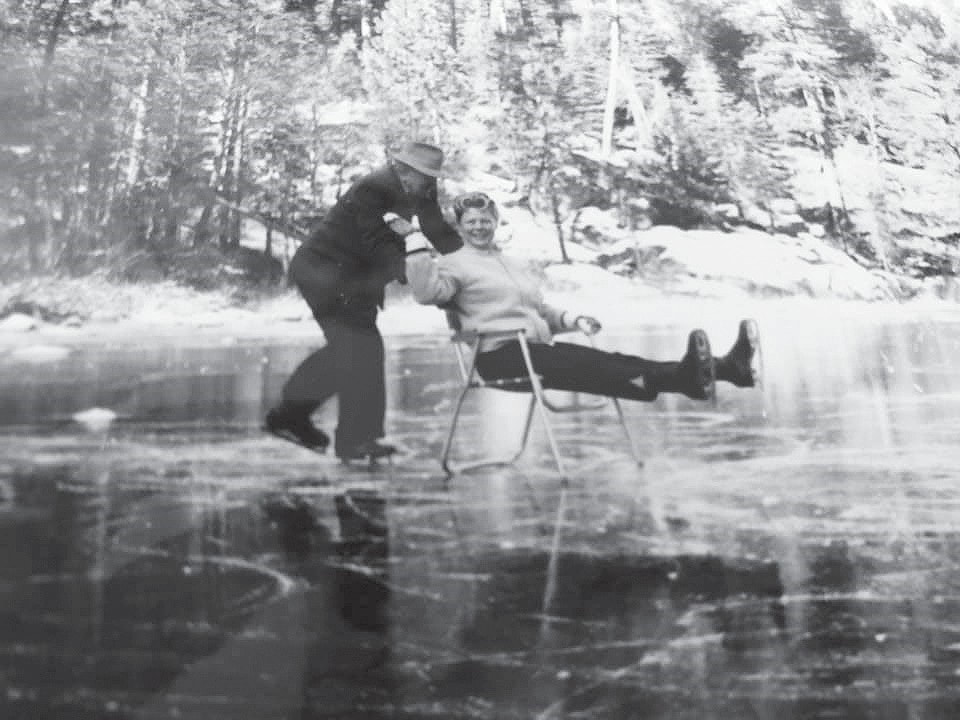
Norman and Pat May are shown playing on the frozen river at Camp Chilnualna sometime before their kids were born — Photo courtesy of Garth May
Norman continued in his recollection. “In 1942 I took a ‘leave of absence’ from Camp Chilnualna. I had just graduated from high school and I joined the Marines. I will never forget the first words of our D.I. (drill instructor) in boot camp, ‘You guys are hired killers and I am here to show you how to do it!’”
After six “hasty” weeks of boot camp, the Marines were immediately sent to the Island of Midway to be on what Norm called the “reception committee for the expanding Japanese Empire.”
“I was gone for three years before returning to Camp Chilnualna, 20 months of which was spent in the South Pacific,” Norm wrote.
Garth says his dad came home from the war and never left again.
“In 1949 Camp Chilnualna expanded even more,” penned Norm. “We built a restaurant and called it ‘Chilnualna Lodge Café.’ They leased out land where others built a theatre, service station and garage, and the area was turning into the heart of Wawona.
Norman continued in his recollection. “In 1942 I took a ‘leave of absence’ from Camp Chilnualna. I had just graduated from high school and I joined the Marines. I will never forget the first words of our D.I. (drill instructor) in boot camp, ‘You guys are hired killers and I am here to show you how to do it!’”
After six “hasty” weeks of boot camp, the Marines were immediately sent to the Island of Midway to be on what Norm called the “reception committee for the expanding Japanese Empire.”
“I was gone for three years before returning to Camp Chilnualna, 20 months of which was spent in the South Pacific,” Norm wrote.
Garth says his dad came home from the war and never left again.
“In 1949 Camp Chilnualna expanded even more,” penned Norm. “We built a restaurant and called it ‘Chilnualna Lodge Café.’ They leased out land where others built a theatre, service station and garage, and the area was turning into the heart of Wawona.
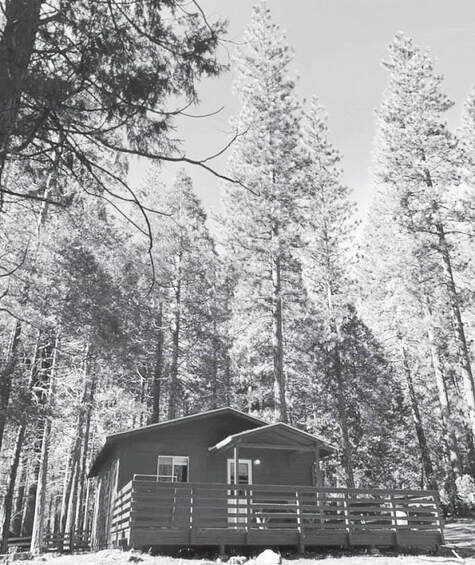
“The restaurant was going great. We had only been open a year (1950) when the worst happened. The Korean War broke out, and even though I was in the inactive reserve, I was called back immediately for my specialty, MTACS (Marine Tactical Air Control), acting as a forward observer calling in air strikes on enemy positions.”
After 13 months and nearly on the eve of his departure for Korea, the high command decided that Norman May’s extensive service in WW II had been enough, and they gave him the option of going to Korea or getting out.
“Needless to say, I chose the latter.
“I have wandered far a-field from Camp Chilnualna and Wawona, but I wanted to mention how much my getting called back into the Marines disrupted our lives and the course of events for Camp Chilnualna. It was impossible for my parents to continue on trying to run the cabins and restaurants in my absence.”
A creekside cabin at Camp Chilnualna looks out on the south
fork of the Merced River.
The restaurant was leased out to another in what Norm considered a good move, and things went pretty well until the sudden death of Edna from cancer in the fall of 1960.
“This kind of threw things out of ‘gear’ again,” said her grieving son Norman. “My mother was a strong woman. She knew what hard work was and she wasn’t afraid of it. I must say that her strength, perseverance and tenacity [were] the glue that held Camp Chilnualna together in the early days.”
Broken hearts, a new start
With the loss of Edna, said her grandson Garth, “every heart was broken.”
By that time, Norman had already met Patty Lee, a city girl turned mountain woman, originally from North Hollywood. Pat had fallen in love with Wawona during summers there as a girl and eventually scraped and saved to purchase her own small cabin near Camp Chilnualna. That’s how she met Norm.
Pat “stepped unflinchingly into the enormous void left by Edna when she passed,” Garth learned later. “Mom carried them through that time. She and dad were married a year later up at Sentinel Dome, but she became family at that moment.”
Over the years, the May family built new cabins, tore down some old ones, and expanded into property management, continuing to welcome visitors onto the grounds and into their home, where they’d hold court from a big square wooden table while seasons passed at the modest resort inside the giant national park. Time here was said to be elastic.
“Nobody ever knocked on our door, they just walked in,” Garth said.
By the 1970s, some of the Camp Chilnualna cabins and others in the growing area were being managed by an association of homeowners established inside Wawona, known as The Redwoods. Back then, The Redwoods had about 40 cottages under its umbrella; today they handle about 120.
The Camp Chilnualna Cabins, however, remain much as they have for decades. The same goes for Wawona, pretty much, according to Garth and some others who have been around long enough to know.
Back then, he says, the place “wasn’t that different than it is now, really. There are much larger homes, now, and a few more people, but not a lot more people. There are about the same number of kids going to the school down the street as when I was a kid. There are a lot more regulations and things; there’s a rule and a law for everything these days, it seems.
“Burrel Maier has been the stage driver at the history center in the summertime since the 70s. He said to me one day, ‘You know, the only people who say Wawona’s changing too much are folks that haven’t lived here long enough.’ And I totally got what he meant by that. It really is, remarkably, the same kind of vibe even as decades pass.”
Family tradition
Like his dad before him, Garth May left Wawona for a time and lived in the Bay Area, earning a degree in humanities and making music as far away as Tokyo. Once, he found a random postcard someone sent from Wawona and the unmet writer captured the gentle ambiance as Garth remembered it.
“’We woke up and the deer were in front of the cabin eating grass,’” he read, and “’the bear came last night and knocked the garbage can over.’ It was all just exactly as you would describe it in any given year.”
Eventually returning to his old stomping grounds with the bears, birds and deer, Garth said, “I never looked back and realized this is where I wanted to be.”
Harold May has been gone a while now and, in recent years, both Pat and Norm have passed away. But they and Edna are remembered all the time at Camp Chilnualna, where their spirits live on in the sounds of whispering trees and children’s laughter, the changing seasons and in the steady flow of the mighty Merced.
While much stays the same in Wawona, Garth has noted that the weather seems less predictable, while the threat of fire has become more frequent as a combination of a densely grown forest, years of drought and tree mortality conspired to create hazardous conditions.
“Two out of the last three years we were evacuated for a week or so, in spite of my family being here 80-plus years and we had never experienced an evacuation for anything up to that point.”
He’s comforted by the patchwork of defensible space created as each fire is fought and contained.
The modern era
These days, the internet has proved to be a good thing for vacation rentals in Wawona, as Airbnb and other entities have taken on the reservation tasks previously handled in the office. Garth enjoys the convenience of the Airbnb model and credits much of the establishment’s reputation for excellent reviews to Camp Chilnuala’s indispensible live-in manager, the lovely Margina Jones.
“We have guests from all over the world,” Margina shared, saying she’s enjoyed reading reservation request letters from the old days when that’s how business was conducted — slowly — at a pace that seems more naturally akin to Wawona than today’s high-speed internet.
“Wawona is a sacred, beautiful place that will help ground you in the present moment, always being surrounded by the beauty of the river, the trees, the animals,” Margina said. “Just taking a short walk outside here will help bring peace to your heart. It’s a place to always be honored and respected.”
It’s especially peaceful now, in the off-season, when Margina and Garth are busily challenged with the mundane but necessary chores associated with keeping living history intact: installing floors, cleaning cabins, cutting wood and generally shoring up the place, ever accompanied by their constant canine sidekicks.
Dogs, by the way, are welcome visitors at Camp Chilnualna, where everyone is made to feel at home and Garth’s small slice of paradise is, by far, the best place to be.
“My friends that have come up here over the years, they loved my family and they love Yosemite and Wawona. I look up at the trees in the day and the stars at night — and there’s always something interesting going on.”
After 13 months and nearly on the eve of his departure for Korea, the high command decided that Norman May’s extensive service in WW II had been enough, and they gave him the option of going to Korea or getting out.
“Needless to say, I chose the latter.
“I have wandered far a-field from Camp Chilnualna and Wawona, but I wanted to mention how much my getting called back into the Marines disrupted our lives and the course of events for Camp Chilnualna. It was impossible for my parents to continue on trying to run the cabins and restaurants in my absence.”
A creekside cabin at Camp Chilnualna looks out on the south
fork of the Merced River.
The restaurant was leased out to another in what Norm considered a good move, and things went pretty well until the sudden death of Edna from cancer in the fall of 1960.
“This kind of threw things out of ‘gear’ again,” said her grieving son Norman. “My mother was a strong woman. She knew what hard work was and she wasn’t afraid of it. I must say that her strength, perseverance and tenacity [were] the glue that held Camp Chilnualna together in the early days.”
Broken hearts, a new start
With the loss of Edna, said her grandson Garth, “every heart was broken.”
By that time, Norman had already met Patty Lee, a city girl turned mountain woman, originally from North Hollywood. Pat had fallen in love with Wawona during summers there as a girl and eventually scraped and saved to purchase her own small cabin near Camp Chilnualna. That’s how she met Norm.
Pat “stepped unflinchingly into the enormous void left by Edna when she passed,” Garth learned later. “Mom carried them through that time. She and dad were married a year later up at Sentinel Dome, but she became family at that moment.”
Over the years, the May family built new cabins, tore down some old ones, and expanded into property management, continuing to welcome visitors onto the grounds and into their home, where they’d hold court from a big square wooden table while seasons passed at the modest resort inside the giant national park. Time here was said to be elastic.
“Nobody ever knocked on our door, they just walked in,” Garth said.
By the 1970s, some of the Camp Chilnualna cabins and others in the growing area were being managed by an association of homeowners established inside Wawona, known as The Redwoods. Back then, The Redwoods had about 40 cottages under its umbrella; today they handle about 120.
The Camp Chilnualna Cabins, however, remain much as they have for decades. The same goes for Wawona, pretty much, according to Garth and some others who have been around long enough to know.
Back then, he says, the place “wasn’t that different than it is now, really. There are much larger homes, now, and a few more people, but not a lot more people. There are about the same number of kids going to the school down the street as when I was a kid. There are a lot more regulations and things; there’s a rule and a law for everything these days, it seems.
“Burrel Maier has been the stage driver at the history center in the summertime since the 70s. He said to me one day, ‘You know, the only people who say Wawona’s changing too much are folks that haven’t lived here long enough.’ And I totally got what he meant by that. It really is, remarkably, the same kind of vibe even as decades pass.”
Family tradition
Like his dad before him, Garth May left Wawona for a time and lived in the Bay Area, earning a degree in humanities and making music as far away as Tokyo. Once, he found a random postcard someone sent from Wawona and the unmet writer captured the gentle ambiance as Garth remembered it.
“’We woke up and the deer were in front of the cabin eating grass,’” he read, and “’the bear came last night and knocked the garbage can over.’ It was all just exactly as you would describe it in any given year.”
Eventually returning to his old stomping grounds with the bears, birds and deer, Garth said, “I never looked back and realized this is where I wanted to be.”
Harold May has been gone a while now and, in recent years, both Pat and Norm have passed away. But they and Edna are remembered all the time at Camp Chilnualna, where their spirits live on in the sounds of whispering trees and children’s laughter, the changing seasons and in the steady flow of the mighty Merced.
While much stays the same in Wawona, Garth has noted that the weather seems less predictable, while the threat of fire has become more frequent as a combination of a densely grown forest, years of drought and tree mortality conspired to create hazardous conditions.
“Two out of the last three years we were evacuated for a week or so, in spite of my family being here 80-plus years and we had never experienced an evacuation for anything up to that point.”
He’s comforted by the patchwork of defensible space created as each fire is fought and contained.
The modern era
These days, the internet has proved to be a good thing for vacation rentals in Wawona, as Airbnb and other entities have taken on the reservation tasks previously handled in the office. Garth enjoys the convenience of the Airbnb model and credits much of the establishment’s reputation for excellent reviews to Camp Chilnuala’s indispensible live-in manager, the lovely Margina Jones.
“We have guests from all over the world,” Margina shared, saying she’s enjoyed reading reservation request letters from the old days when that’s how business was conducted — slowly — at a pace that seems more naturally akin to Wawona than today’s high-speed internet.
“Wawona is a sacred, beautiful place that will help ground you in the present moment, always being surrounded by the beauty of the river, the trees, the animals,” Margina said. “Just taking a short walk outside here will help bring peace to your heart. It’s a place to always be honored and respected.”
It’s especially peaceful now, in the off-season, when Margina and Garth are busily challenged with the mundane but necessary chores associated with keeping living history intact: installing floors, cleaning cabins, cutting wood and generally shoring up the place, ever accompanied by their constant canine sidekicks.
Dogs, by the way, are welcome visitors at Camp Chilnualna, where everyone is made to feel at home and Garth’s small slice of paradise is, by far, the best place to be.
“My friends that have come up here over the years, they loved my family and they love Yosemite and Wawona. I look up at the trees in the day and the stars at night — and there’s always something interesting going on.”
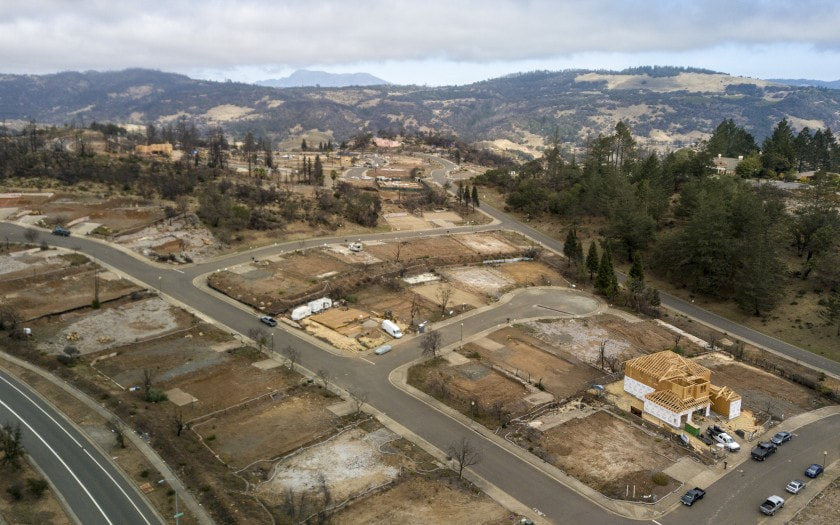
Bill would force companies to keep insuring homeowners in wildfire zones. Will it work?
By JOSEPH SERNA LA Times STAFF WRITER
FEB. 18, 2020
Insurance companies fleeing high-risk fire zones would have to stay put and even offer discounts if homeowners in those areas prepare for wildfires on a community-wide scale, under a new bill proposed in Sacramento on Tuesday.
The bill, AB 2367, has the backing of state Insurance Commissioner Ricardo Lara. It would mandate that starting in 2021, insurers would have to renew policies and continue to write new ones in communities that meet state standards for firescaping, or home hardening, that would be established before the law takes effect.
“Homeowners who have done all the right things, hardening their homes and mitigating for fire danger, are still seeing their insurance canceled or non-renewed,” said state Assemblywoman Lorena Gonzalez (D-San Diego), co-author of the bill. “We can’t allow insurance companies to continue to drop responsible homeowners from San Diego to the Sierras just because they can.”
The bill is the latest move from Sacramento to force insurance companies to continue issuing policies in the state’s wildland-urban interface, the gray zone where millions of homeowners reside between suburbia and the forest. As of 2010, roughly one-third of the 13.6 million homes in California were located in this wildfire zone, according to federal data.
Since 2015, insurers have increasingly either boosted premiums or declined to renew homeowner policies in areas recently hit by wildfires or considered at high risk of experiencing one.
Assemblywoman Monique Limón (D-Santa Barbara), said that since the 2017 Thomas fire, homeowners in her district had experienced “unprecedented rates of insurance non-renewals even when the community has been working towards reducing the risk.”
Because of that, the bill’s proponents say, homeowners are finding it increasingly difficult to stay, rebuild or sell their home due to limited options.
“The key here in the long run is mitigation and how do we lessen the risk for homeowners, lessen the risk to the community,” Lara said. “What we’ve seen lately is consumers investing in thousands of dollars [in fire mitigation] without any guarantee they’ll get any coverage or that they won’t get dropped. This will get a fair balance: let’s get mitigation, inspections, then let’s guarantee you.”
Not everyone is convinced the bill is the best path forward. Rex Frazier, president of the Personal Insurance Federation of California, an association of state insurers, questioned the premise that community-wide efforts are sure to reduce the risks of home losses.
“We’re trying to figure out what is within the individual’s and the community’s power to stop property loss,” he said. “For wildfire, there’s no science right now that exists that can reliably predict what demonstrably reduces the risks of a homeowner. We’re not talking about ordinary home fires; we’re talking about mega-events. Even homes built to the 2008 standards in Paradise, only 50% of those homes survived.”
There are still a number of details to be worked out before the bill takes effect.
A task force that includes officials with the California Office of Emergency Services, State Fire Marshal, California Department of Forestry and Fire Management and the Governor’s Office of Planning and Research would need to come up with standards for home and community-wide firescaping, a method of maintaining land and property to reduce fire behavior and possible ignitions. The task force would consult with the insurance industry and the standards would differ depending on each community’s risks, Lara said.
Although there’s money in the budget to explore the issue, Lara said, it’s unclear ultimately who will be responsible for certifying that fire defense standards are met and then maintained. It’s also not clear how low-income or disabled residents would meet the standards if they cannot afford to do them or are physically unable to. The law would apply only to existing homes where there’s been an abrupt change in insurance availability, officials said.
Some experts see the legislation as a partial step in the right direction.
“The high-profile nature of the law makes it valuable in raising the profile of the issue,” said Lisa Dale, who teaches sustainable development at Columbia University’s Earth Institute. “It’s signaling a market-shift in these dynamics and it’s putting homeowners on notice that they’re going to be responsible for managing their own risk.”
That said, she added, “I’m very skeptical it will get us the outcomes we want.”
By JOSEPH SERNA LA Times STAFF WRITER
FEB. 18, 2020
Insurance companies fleeing high-risk fire zones would have to stay put and even offer discounts if homeowners in those areas prepare for wildfires on a community-wide scale, under a new bill proposed in Sacramento on Tuesday.
The bill, AB 2367, has the backing of state Insurance Commissioner Ricardo Lara. It would mandate that starting in 2021, insurers would have to renew policies and continue to write new ones in communities that meet state standards for firescaping, or home hardening, that would be established before the law takes effect.
“Homeowners who have done all the right things, hardening their homes and mitigating for fire danger, are still seeing their insurance canceled or non-renewed,” said state Assemblywoman Lorena Gonzalez (D-San Diego), co-author of the bill. “We can’t allow insurance companies to continue to drop responsible homeowners from San Diego to the Sierras just because they can.”
The bill is the latest move from Sacramento to force insurance companies to continue issuing policies in the state’s wildland-urban interface, the gray zone where millions of homeowners reside between suburbia and the forest. As of 2010, roughly one-third of the 13.6 million homes in California were located in this wildfire zone, according to federal data.
Since 2015, insurers have increasingly either boosted premiums or declined to renew homeowner policies in areas recently hit by wildfires or considered at high risk of experiencing one.
Assemblywoman Monique Limón (D-Santa Barbara), said that since the 2017 Thomas fire, homeowners in her district had experienced “unprecedented rates of insurance non-renewals even when the community has been working towards reducing the risk.”
Because of that, the bill’s proponents say, homeowners are finding it increasingly difficult to stay, rebuild or sell their home due to limited options.
“The key here in the long run is mitigation and how do we lessen the risk for homeowners, lessen the risk to the community,” Lara said. “What we’ve seen lately is consumers investing in thousands of dollars [in fire mitigation] without any guarantee they’ll get any coverage or that they won’t get dropped. This will get a fair balance: let’s get mitigation, inspections, then let’s guarantee you.”
Not everyone is convinced the bill is the best path forward. Rex Frazier, president of the Personal Insurance Federation of California, an association of state insurers, questioned the premise that community-wide efforts are sure to reduce the risks of home losses.
“We’re trying to figure out what is within the individual’s and the community’s power to stop property loss,” he said. “For wildfire, there’s no science right now that exists that can reliably predict what demonstrably reduces the risks of a homeowner. We’re not talking about ordinary home fires; we’re talking about mega-events. Even homes built to the 2008 standards in Paradise, only 50% of those homes survived.”
There are still a number of details to be worked out before the bill takes effect.
A task force that includes officials with the California Office of Emergency Services, State Fire Marshal, California Department of Forestry and Fire Management and the Governor’s Office of Planning and Research would need to come up with standards for home and community-wide firescaping, a method of maintaining land and property to reduce fire behavior and possible ignitions. The task force would consult with the insurance industry and the standards would differ depending on each community’s risks, Lara said.
Although there’s money in the budget to explore the issue, Lara said, it’s unclear ultimately who will be responsible for certifying that fire defense standards are met and then maintained. It’s also not clear how low-income or disabled residents would meet the standards if they cannot afford to do them or are physically unable to. The law would apply only to existing homes where there’s been an abrupt change in insurance availability, officials said.
Some experts see the legislation as a partial step in the right direction.
“The high-profile nature of the law makes it valuable in raising the profile of the issue,” said Lisa Dale, who teaches sustainable development at Columbia University’s Earth Institute. “It’s signaling a market-shift in these dynamics and it’s putting homeowners on notice that they’re going to be responsible for managing their own risk.”
That said, she added, “I’m very skeptical it will get us the outcomes we want.”
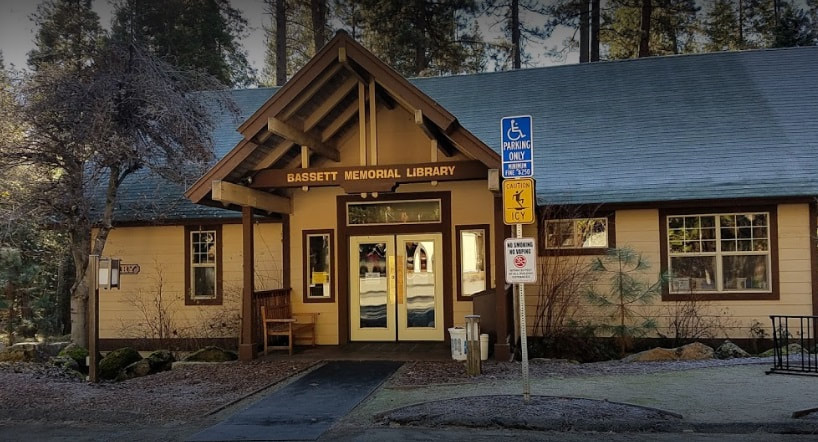
Ballot Box in Wawona Library
A ballot box is available at the Wawona Bassett Memorial Library Mon., Wed., Fri. (12 p.m. - 5 p.m.) and Sat. (10 a.m. - 3 p.m.) to return your completed ballots.
Ballots will be picked up weekly.
Keith Williams
Mariposa County Treasurer, Tax Collector, County Clerk
A ballot box is available at the Wawona Bassett Memorial Library Mon., Wed., Fri. (12 p.m. - 5 p.m.) and Sat. (10 a.m. - 3 p.m.) to return your completed ballots.
Ballots will be picked up weekly.
Keith Williams
Mariposa County Treasurer, Tax Collector, County Clerk
